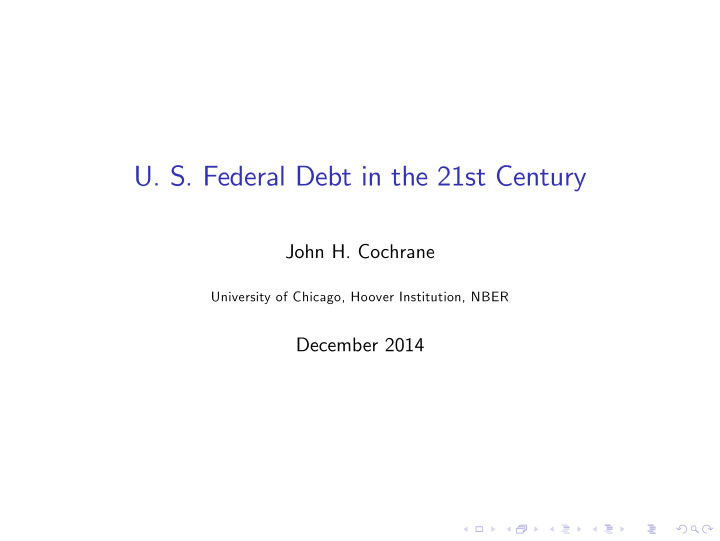



U. S. Federal Debt in the 21st Century John H. Cochrane University of Chicago, Hoover Institution, NBER December 2014
Outline Structure of U.S. Debt? 1. Fixed-value floating rate. 2. Nominal perpetuities 3. Indexed perpetuities 4. Taxable + tax free 5. Variable coupon 6. Swaps 7. Fed/Treasury accord on maturity, real/nominal, etc. Goals 1. Funding debt at least cost. Easy to borrow when needed. 2. Providing liquid and useful securities, where the Government has a natural advantage. Both policy and #1. 3. Managing interest rate and other risks to the U. S. budget. 4. Tools for optimal fiscal (-monetary?) policy. Goals today 1. Why not? Unforeseen problems? Objections? Additions?
Short debt Features � Fixed-value ($1.00), floating-rate, electronically transferable, arbitrary denominations, perpetual. Sexy name? � Fixed value: Buy/sell freely ($1 reserves = 1 bond). Accept for taxes. � Rate = interest on reserves. (Depends on Fed policy. Auctions, index, if not?) Why � No rollover, no rollover costs. (Sorry, dealers.) � Basis for better retail electronic transactions. � Best fills “liquidity (collateral?) demand” for government debt. � Run free interest-paying electronic money = 21st century currency. � “Optimal quantity of money.” Reserves for all! Objections � Q: Demand? A: Fed innovations popular, and useful if small. � Q: Quantity not perfectly controlled. A: A problem? � Q: Price level control? A: MV=PY a lost cause. Fed retains (strengthens) i control. � ?
Long debt Perpetuities � $1 coupon forever. Repay by repurchasing. � Pay with fixed value debt? � Let current debt roll off. Why � Liquidity. One security! No on/off run spread. � Much historical precedent. Objections � Q: Desire for coupon debt? A: Why? Easy for banks/funds to synthesize coupons or zeros for retail customers. � ?
Tax status Tax-free debt � Issue both taxable and tax free flavors. � Free of all Federal tax including personal and corporate income tax and estate taxes. Press states/local to exempt as well. Why � The point of debt is to get money now at expense of future taxes. Tax free debt has a higher yield, collect the future taxes now. � Investors may prefer to overpay now and avoid complex legal and tax avoidance costs later. � Removes intertemporal distortions, can supplant much complex tax-sheltered investing. Objections � Q: “Lose tax revenue.” A: No. Collect it sooner. � ?
Inflation Indexed debt � Perpetual. Coupon pays $1 times × CPI . � Example: CPI today = 230. Coupon pays $2.30. Why / alternatives � One security, independent of issue date. Should increase liquidity. � Symmetric treatment of inflation / deflation. � (Tax free) Indexed perpetuity = ideal risk free asset. → Large demand, low yield. � For other countries: Domestic vs. foreign currency debt. U.S? Objections � ?
Government equity Variable coupon debt � Perpetuities with the right to raise or lower coupon payments without legal default. � Politics: Treasury? Act of Congress? Why � Seamlessly reduce payments in times of fiscal stress. Alternatives � Rules vs. reputations. Trills. Corporate dividends. Voters = shareholders? � Analogy: Suspensions of Convertibility. � All debt (better ex post, fewer kinds of debt)? Or part only (cheaper yields ex ante)? Objections � ?
Risk management Swaps � Fixed-floating; Indexed-nominal. � Others? Taxable-nontaxable? All? Why � Separate liquidity provision, meeting market demands for specific bonds, from risk exposure. � Example: Market wants lots of floating rate “money-like” debt. But if interest rates rise, interest costs rise. Solution: issue lots of floating-rate, swap to fixed. � Implicit: demand for characteristics beyond maturity. Demand for bonds � = demand for swaps. � Allows quicker adjustments of maturity/index/tax structure than buying and selling bonds. � Tradeable treasury swaps should be liquid and popular in the secondary market. Objections � Q: Swap counterparty risk? A: Collateralized, and what is all this regulation for anyway? � ?
Accord Needed: New Fed-Treasury Accord � No more we sell, you buy. � Who is in charge of the maturity/index/tax structure of debt? (Treasury?) � Who is in charge of short term interest rates? (Fed, via IOR?) How do we use these tools? � Optimal (state-contingent) maturity structure (bonds+swaps)? Index vs. nonindex? Or target spread? Taxable vs tax free? (Or target spread) How much variable coupon debt? When to raise/lower the coupons? � Long but unconcluded optimal-taxation, optimal-debt literature (e.g. Lucas-Stokey.) � Once you know the answers, most have macro (Fed) and budgetary (Congress) as well as debt-cost (Treasury) implications. Accord/coordination is not simple.
Recommend
More recommend